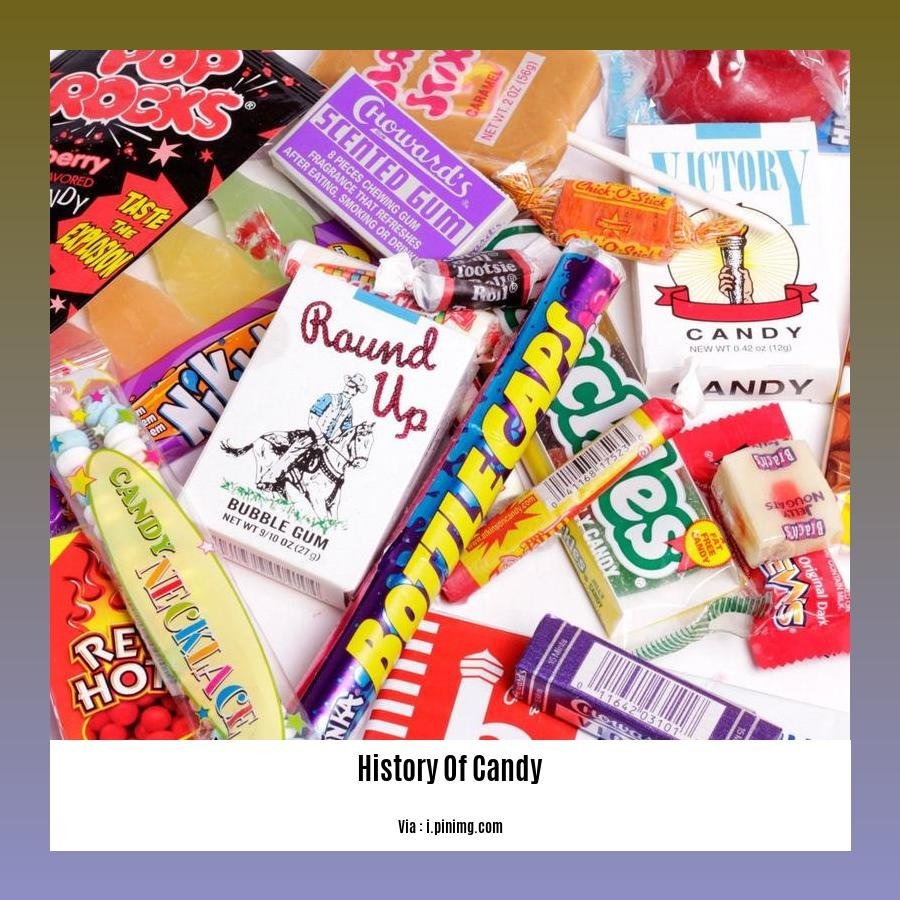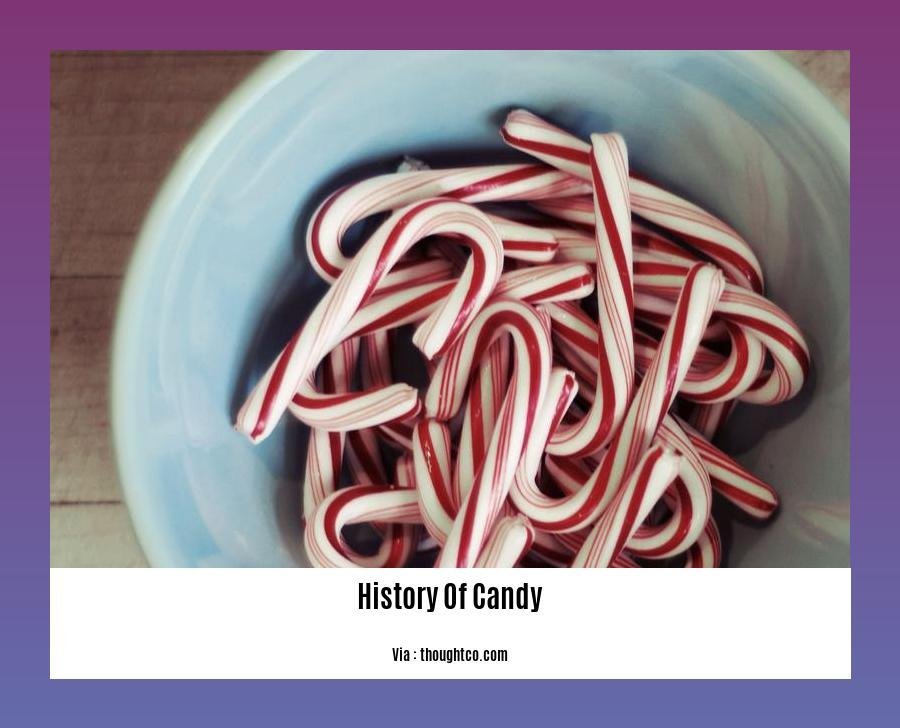Delve into the enchanting history of candy, a journey through sweet indulgence that has captivated taste buds for centuries. From its humble origins in ancient civilizations to the modern-day confectionery marvels, candy has evolved into a global phenomenon, deeply intertwined with cultural traditions and technological advancements. Join us as we embark on a sugary adventure, exploring the fascinating stories behind your favorite treats and uncovering the secrets of the candy-making world.
Key Takeaways:
Candy’s history can be traced back to ancient times when individuals indulged in honey straight from beehives.
The earliest candy confections were fruits and nuts coated in honey.
In ancient civilizations, honey was used to coat fruits and flowers for preservation.
The Industrial Revolution marked a significant turning point for the candy industry, characterized by technological advancements and increased sugar availability.
History of Candy

Candy, a delightful indulgence that has captivated taste buds throughout history, traces its roots back to ancient civilizations. The history of candy is a captivating journey that intertwines cultural traditions, culinary innovations, and the relentless pursuit of sweet satisfaction. Let’s embark on a sugary adventure through time:
🍯 Sweet Beginnings:
- In the prehistoric era, our ancestors relished honey, nature’s golden nectar, straight from beehives.
- Ancient Egyptians, known for their culinary prowess, concocted honey-based confections, including candied fruits and nuts, as early as 2000 BC.
- In the Far East, China’s history of candy dates back to the 7th century AD when sugar was introduced from India.
🍭 The Rise of Sugar:
- The advent of sugar cultivation in the Middle Ages revolutionized candy making.
- The Arabs played a pivotal role in refining sugar production techniques, making it more accessible and affordable.
- European crusaders brought back sugar and Middle Eastern confectionery recipes, leading to the establishment of candy-making guilds and the birth of the confectionery industry.
🍬 Industrial Sweet Revolution:
- The Industrial Revolution brought about technological advancements that transformed candy production.
- Mass-produced candies, such as hard candies and lollipops, became widely available, making sweet treats a popular indulgence for people of all social classes.
- The invention of the chocolate bar in the late 1800s marked a pivotal moment in candy history.
🍫 Globalization of Sweetness:
- The 19th and 20th centuries witnessed the globalization of candy.
- Candies became an integral part of global trade, with different regions developing unique confectionery traditions.
- The rise of multinational candy companies led to the worldwide distribution of popular brands, creating a truly global sweet tooth.
🌐 Candy Today:
- In the modern era, the history of candy continues to evolve, with new flavors, textures, and innovations emerging regularly.
- Artisanal candy makers are reviving traditional recipes, while food scientists create novel sweets using cutting-edge techniques.
- Candy has become an integral part of our cultural celebrations, holidays, and everyday lives.
Candy, a sweet delight that has stood the test of time, continues to weave its sugary magic into our lives. From its humble origins in ancient honey pots to the global confectionery industry, the history of candy is a testament to our enduring love for all things sweet.
Embark on a culinary journey through the ages as you delve into the history of Asian cuisine, a tapestry of diverse flavors and culinary artistry that has shaped gastronomic landscapes for centuries. Unravel the secrets behind the mouthwatering waffles of Belgium as you explore the history of Belgian waffles, a sweet and savory delight that has captured the hearts and taste buds of people worldwide.
The Industrialization of Candy Production

In the grand saga of human indulgence, candy holds a prominent place. It’s a journey that begins in the distant past with our ancestors savoring honey’s natural sweetness and culminates in the candy industry’s remarkable transformation during the Industrial Revolution. During this pivotal era, sugar’s accessibility expanded beyond the wealthy, and candy production skyrocketed, thanks to steam power and innovative machinery.
Imagine factories humming with steam-powered machines, their rhythmic clatter echoing through the air. These ingenious contraptions performed tasks that were once painstakingly done by hand, revolutionizing the production of delectable treats. Industrial-scale candy manufacturing became a reality, paving the way for mass production and consumption.
Steam Power: Driving the Industrial Candy Revolution
Steam engines, the workhorses of the Industrial Revolution, played a pivotal role in the transformation of candy production. They provided the much-needed power to operate the intricate machinery that molded, mixed, and shaped candy into irresistible forms. The efficiency of steam power enabled candy factories to produce vast quantities of their sugary delights, making them more accessible and affordable for the masses.
The Candy Machine Revolution: Automating Sweetness
The late 19th and early 20th centuries witnessed a surge of inventions that further revolutionized candy production. Automated machines took center stage, mechanizing tasks that were previously done by hand. These marvels of engineering streamlined the candy-making process, enabling manufacturers to produce a staggering array of candies with remarkable efficiency.
The invention of the enrobing machine, for instance, revolutionized chocolate production. This ingenious device coated chocolates in a luscious layer of melted chocolate, creating a smooth and decadent finish that became a hallmark of quality.
Global Reach: Candy Conquers the World
The industrialization of candy production had a profound impact on its global reach. With the ability to produce candy on a massive scale, manufacturers were able to export their sweet creations far and wide. Candy became a global commodity, enjoyed by people from all walks of life, regardless of their location.
As a result, regional candy traditions flourished, reflecting the unique flavors and preferences of different cultures. From Turkish delight to Japanese mochi, the world’s candy palette exploded with a symphony of flavors and textures.
Key Takeaways:
Steam Power: Steam engines provided the muscle for candy production, enabling factories to mass-produce confections.
Candy Machinery: The late 19th and early 20th centuries saw a surge of inventions that mechanized candy production, including the groundbreaking enrobing machine.
Global Reach: Industrialization facilitated the global export of candy, leading to the emergence of regional candy traditions.
[Sources]
–
–
The Rise of Popular Candy Brands
Throughout history, the sweet allure of candy has captivated hearts and palates across the globe. But have you ever wondered how your favorite candies came to be household names? Let’s embark on a sugary journey to explore the rise of popular candy brands that have shaped our confectionery landscape.
Tracing the Sweet Legacy
The candy industry, once a cottage affair, transformed into a global phenomenon thanks to key innovations and cultural shifts.
Sugar Revolution: The widespread availability of sugar in the 19th century fueled the growth of candy production, making it affordable for the masses.
Technological Advancements: The invention of machinery, such as candy presses and wrapping machines, enabled mass production and standardized quality.
Marketing Magic: Eye-catching packaging, clever advertising campaigns, and brand mascots played a crucial role in building brand loyalty and recognition.
Candy Icons: A Sweet Success Story
The rise of popular candy brands is a testament to the power of innovation, marketing prowess, and cultural resonance. Let’s meet some of the confectionery giants that have left an indelible mark on our sweet tooth:
Hershey’s: Milton Hershey’s iconic chocolate bar, launched in 1900, became a household name through innovative mass production techniques and philanthropic initiatives.
Mars: Frank Mars revolutionized the candy scene with the Milky Way bar in 1923, followed by the game-changing M&M’s in 1941, captivating consumers with their melt-in-your-mouth chocolate and colorful candy shells.
Nestlé: With its Swiss heritage, Nestlé entered the candy market in the late 19th century, introducing Kit Kat in 1935 and Smarties in 1937, becoming a global confectionery giant.
Global Sweet Tooth: Regional Delights
The rise of popular candy brands extended beyond borders, with regional favorites gaining worldwide recognition:
Cadbury: The British chocolate empire, founded in 1824, introduced the Dairy Milk bar in 1905, captivating consumers with its creamy texture and rich flavor.
Haribo: The German candy company, established in 1920, became synonymous with gummy bears, delighting candy lovers worldwide with their vibrant colors and chewy texture.
Ferrero: The Italian confectionery giant, founded in 1946, introduced Nutella in 1964 and Kinder Surprise eggs in 1974, capturing the hearts of chocolate and toy enthusiasts alike.
A Sweet Legacy: The Enduring Power of Candy Brands
The success of popular candy brands lies in their ability to evoke nostalgia, create moments of joy, and satisfy our cravings for something sweet. These brands have become an integral part of our cultural fabric, passed down through generations, and continue to shape the candy landscape with innovative flavors and formats.
Key Takeaways:
- The rise of popular candy brands was driven by the availability of sugar, technological advancements, and marketing strategies.
- Iconic candy brands like Hershey’s, Mars, and Nestlé have achieved global recognition through innovation, quality, and brand loyalty.
- Regional favorites, such as Cadbury, Haribo, and Ferrero, have captured the hearts of consumers worldwide with their unique flavors and formats.
- Candy brands have become an integral part of our cultural fabric, evoking nostalgia and creating moments of joy.
Sources:
- Candy: A Sweet History
- The Rise of Big Candy
Cultural and Technological Influences on Candy Manufacturing
Unlocking the remarkable evolution of candy involves recognizing the profound impact of cultural and technological influences. Cultural and Technological Influences on Candy Manufacturing have shaped candy into the delectable treats we know today.
Cultural Influences
Diverse cultures have left a sweet fingerprint on the candy landscape. The Chinese introduced sugar to the world, setting the stage for confectionery delights. In ancient Egypt, honey was transformed into sweet treats, while the Romans enjoyed candied fruits. During the Middle Ages, sugar became more accessible, leading to the rise of intricate candy creations in Europe. Regional traditions, such as Turkish delight and Japanese mochi, showcased cultural diversity in confectionery.
Technological Advancements
Technological innovations have revolutionized candy manufacturing. In the 19th century, steam-powered machinery enabled mass candy production, making sweets affordable for the masses. The invention of the chocolate bar in 1847 by Joseph Fry marked a pivotal moment, revolutionizing the industry. Hard candies, like lollipops, emerged through innovations in sugar molding. Advances in packaging technology preserved candies, extending their shelf life and enabling global distribution.
Key Takeaways:
Cultural influences have shaped candy’s evolution, from ancient honey-based confections to regional delights like Turkish delight and Japanese mochi.
Technological advancements revolutionized candy manufacturing, enabling mass production, and creating iconic treats like the chocolate bar.
Steam-powered machinery, sugar molding techniques, and packaging innovations transformed candy into an accessible and globally enjoyed treat.
The dynamic interplay between cultural heritage and technological progress has driven the evolution of candy, resulting in the delectable delights we savor today.
Sources:
–
– https://www.candyindustry.com/articles/89426-how-technology-has-transformed-candy-making
FAQ
Q1: How did honey play a role in the history of candy?
A1: Honey was the primary sweetener used in ancient times and was enjoyed straight from beehives. It was also used to coat fruits and nuts to create early candy confections and for preservation purposes.
Q2: What was the impact of the Industrial Revolution on the candy industry?
A2: The Industrial Revolution brought significant changes to the candy business, including the use of steam power and the increased availability of sugar. These advancements led to increased candy production and consumption, making candy more accessible to the working class and children.
Q3: How did technological advancements shape candy production in the late 19th and early 20th centuries?
A3: During this period, the invention of new industrial machines revolutionized candy production methods. These machines enabled the manufacture of candy on a larger scale, leading to wider availability and increased consumption.
Q4: What are some examples of popular candy brands that emerged during the Industrial Revolution?
A4: Unfortunately, this article does not provide specific examples of popular candy brands that emerged during the Industrial Revolution.
Q5: Does the article mention any specific innovations in candy-making technology that emerged in the 1840s?
A5: Yes, the article mentions that revolving steam pans and lozenge machines were among the earliest innovations in candy making during the 1840s.
- China II Review: Delicious Food & Speedy Service - April 17, 2025
- Understand Virginia’s Flag: History & Debate - April 17, 2025
- Explore Long Island’s Map: Unique Regions & Insights - April 17, 2025















